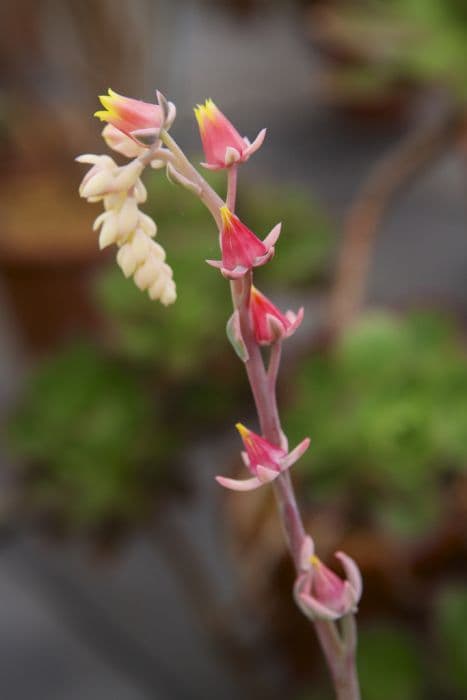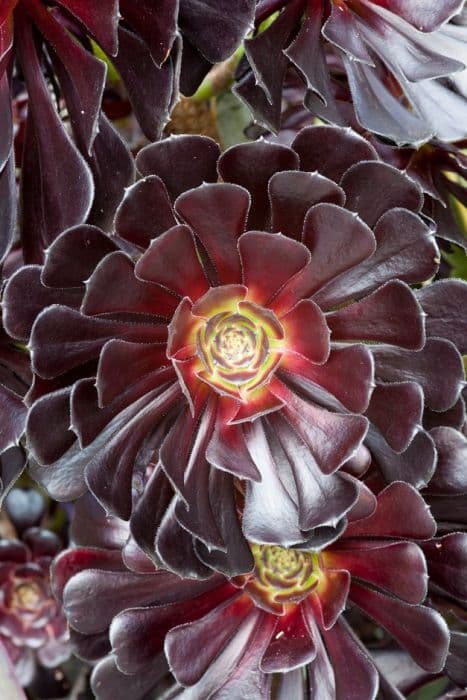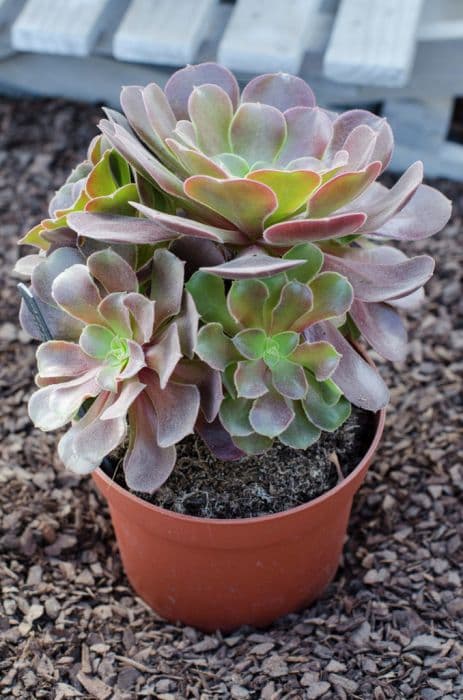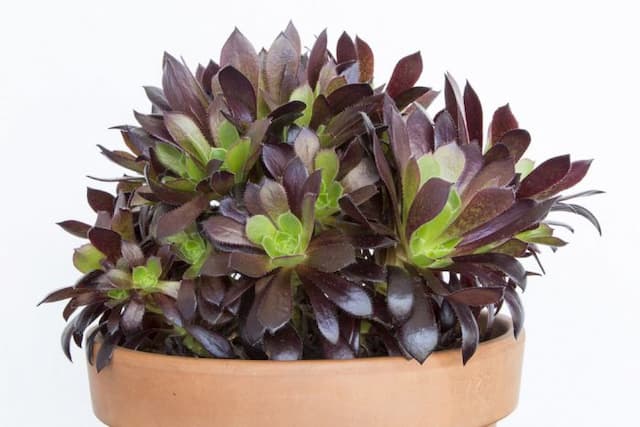Compton Carousel Echeveria secunda f. secunda 'Compton Carousel'

ABOUT
Echeveria 'Compton Carousel' is a visually striking succulent known for its captivating rosette formation. The predominantly green leaves are elegantly patterned with creamy-white variegation, giving each leaf an individual, unique appearance. The variegation can appear as broad, irregular bands or stripes, adding a marbled look to the overall aesthetic. Leaves are fleshy, plump, and slightly pointed at the tips, radiating outwards from the center of the rosette in a symmetrical pattern that can be quite mesmerizing. During its blooming period, it sends up a flower stalk that bears bell-shaped flowers in a pinkish-red hue with a delicate, yellow-tipped petal edge that adds a delightful contrast to the foliage. The plant's ornamental appeal lies in its beautifully arranged foliage that creates a visual texture and color contrast, making it a favorite amongst succulent enthusiasts for both container gardening and rock garden displays.
About this plant
 Names
NamesSynonyms
Compton Carousel, Carousel Echeveria
Common names
Echeveria secunda f. secunda 'Compton Carousel'.
 Toxicity
ToxicityTo humans
Echeveria 'Compton Carousel', also known simply as Echeveria, is generally considered non-toxic to humans. Ingesting any part of the plant is unlikely to cause poisoning or serious harm. However, it is always good practice to avoid eating ornamental plants as they are not intended for human consumption and individual sensitivities can vary.
To pets
Echeveria 'Compton Carousel', commonly referred to as Echeveria, is also generally considered non-toxic to pets, such as cats and dogs. Pets that ingest parts of this succulent may experience mild gastrointestinal discomfort due to the unusual texture and constituents of the plant, but it is not expected to cause serious poisoning or long-term health problems.
 Characteristics
CharacteristicsLife cycle
Perennials
Foliage type
Evergreen
Color of leaves
Variegated
Flower color
Pink
Height
6 inches (15 cm)
Spread
8 inches (20 cm)
Plant type
Succulent
Hardiness zones
9
Native area
Mexico
Benefits
 General Benefits
General Benefits- Easy to Care For: Echeveria 'Compton Carousel' requires minimal water, making it a low-maintenance choice for gardeners.
- Drought-Tolerant: This succulent can survive periods of dryness, making it ideal for xeriscaping and water-wise gardens.
- Adds Aesthetic Appeal: With its attractive rosette shape and variegated leaves, it enhances the visual interest of any space.
- Suitable for Containers: Due to its compact size, it can be grown in pots, perfect for balconies and small spaces.
- Attracts Pollinators: Its flowers may attract bees and butterflies, aiding in pollination of surrounding plants.
- Propagates Easily: Leaves and offsets can be used to propagate new plants, making it a sustainable and cost-effective option.
- Versatile: It can be utilized in rock gardens, terrariums, and as part of mixed succulent displays.
- Non-toxic: Safe around pets and children, as it is not known to be toxic if ingested.
- Durable: It's resilient against pests and diseases, requiring fewer pesticides and less care.
- Long-Lived: As a perennial, it has a long lifespan, which means it doesn't need to be replaced frequently.
 Medical Properties
Medical PropertiesThis plant is not used for medical purposes.
 Air-purifying Qualities
Air-purifying QualitiesThis plant is not specifically known for air purifying qualities.
 Other Uses
Other Uses- Photography Prop: Echeveria 'Compton Carousel' can be used as an attractive foreground or background element in macro or close-up photography sessions, due to its detailed and symmetrical rosettes.
- Themed Decorations: It can be incorporated into party or wedding decorations, especially for events with a succulent or garden theme, adding natural and unique visuals to the setting.
- Artistic Inspiration: Artists can use the 'Compton Carousel' as a source of inspiration for patterns and designs in their work, with its radial rosette providing natural symmetry and beauty.
- Fairy Gardens: This succulent works perfectly in whimsical fairy garden designs, fitting into miniature landscapes and being easy to maintain in small settings.
- Education: It can be used in educational settings to teach children and students about plant care, propagation, and horticulture, given its ease of care and ability to propagate from leaves.
- Culinary Presentation: While not edible, the plant can be used as a non-toxic garnish for plating in high-end culinary presentations, providing an organic touch to dishes.
- Stamped Concrete Patterns: The rosette pattern of 'Compton Carousel' can be used as inspiration when designing stamped concrete or other textured surface finishes.
- Jewelry Displays: Jewelers may use these succulents as a natural prop to showcase rings or other small pieces of jewelry due to the striking contrast and stability of the rosettes.
- Texture Rubbings: Leaves and textured surfaces offer an opportunity for artists or children to create crayon or pencil rubbings that capture the intricate detail of the plant's surface.
- Pattern Design: Its distinctive rosette shape can be emulated in various craft projects, including quilting, embroidery, or mosaic tile work, adding an organic motif to manmade designs.
Interesting Facts
 Feng Shui
Feng ShuiThe Echeveria is not used in Feng Shui practice.
 Zodiac Sign Compitability
Zodiac Sign CompitabilityThe Echeveria is not used in astrology practice.
 Plant Symbolism
Plant Symbolism- Perseverance and resilience: As a succulent, Echeveria is known for its ability to withstand tough conditions, symbolizing the strength to endure and persist.
- Beauty and attentiveness: Echeveria 'Compton Carousel', with its ornate rosette pattern and distinct variegation, represents the idea of natural beauty and the careful attention to detail present in nature.
- Timelessness and longevity: This plant can represent eternal love and friendship as it is a long-lived plant, surviving for many years with proper care.
- Adaptability: The Echeveria's ability to adapt to its environment makes it a symbol of versatility and flexibility in life.
- Healing: Some cultures associate succulents like Echeveria with healing due to their medicinal properties and the soothing aesthetic they provide.
 Water
WaterFor Carousel Echeveria, it is crucial to water it thoroughly yet infrequently, ensuring the soil is allowed to dry out completely between waterings. Typically, you will water approximately every 7 to 10 days during the active growth season in spring and summer. Reduce watering to once a month or less during the dormant winter period, depending on the humidity levels of your environment. When you do water, add enough so that it runs out of the drainage holes—this could mean about 4 to 8 ounces for a small pot. Always avoid letting the plant sit in water as this could lead to root rot.
 Light
LightCarousel Echeveria thrives best in bright, indirect sunlight. It can tolerate direct morning sunlight but should be shielded from the harshest midday rays which can scorch its leaves. A southeast- or east-facing window is an ideal spot, providing ample sunlight without the risk of overheating.
 Temperature
TemperatureThe Carousel Echeveria prefers temperatures between 65 and 80 degrees Fahrenheit. It can withstand occasional dips down to 40 degrees Fahrenheit but should not be exposed to freezing temperatures. Ideal growth occurs within the mentioned temperature range, hence, keep the plant away from drafts and extreme heat sources.
 Pruning
PruningPruning is not frequently required for Carousel Echeveria, but you may remove dead or dying leaves carefully to maintain its appearance and promote good air circulation. The best time to prune is in the spring or early summer, which can also encourage the plant to produce more offset pups. Typically, pruning once a year is sufficient unless there are diseased or damaged leaves that need to be removed sooner.
 Cleaning
CleaningAs needed
 Soil
SoilThe best soil mix for the 'Compton Carousel' Echeveria is a well-draining, porous substrate such as cactus or succulent mix combined with perlite or pumice for increased drainage. This type of soil helps prevent root rot and mimics their natural growing conditions. The ideal soil pH for Echeveria is generally around 6.0, slightly acidic to neutral.
 Repotting
Repotting'Compton Carousel' Echeveria should be repotted every two to three years or when the plant outgrows its container. Repotting allows for the refreshing of the soil and gives space for root growth. The best time to repot is during the plant's active growing season, which is spring or early summer.
 Humidity & Misting
Humidity & MistingThe 'Compton Carousel' Echeveria prefers dry air with low humidity levels, which aligns with its native arid habitat. Aim for humidity levels between 40% and 60%, as consistently high humidity can encourage fungal issues and rot.
 Suitable locations
Suitable locationsIndoor
Place in bright, indirect sun; avoid overwatering.
Outdoor
Needs full sun to partial shade, protect from frost.
Hardiness zone
9-11 USDA
 Life cycle
Life cycleThe Echeveria 'Compton Carousel', also known as a variegated sempervivum, begins its life cycle as a seed, which, once germinated in well-draining soil with sufficient warmth and light, will develop into a small rosette. The rosette grows by producing tightly packed leaves in a spiral pattern, forming its characteristic succulent shape while maximizing water retention. As the plant matures, it may produce offsets or "pups" around its base, which can be used for propagation and contribute to the spread of the plant. With adequate care, including sufficient sunlight and minimal watering, the 'Compton Carousel' will eventually blossom in the spring or early summer, displaying dainty flowers atop a tall stalk. After flowering, which is the peak of its reproductive phase, the main rosette typically dies, leaving the pups to continue the next generation. Throughout its life cycle, this echeveria requires little maintenance, making it a popular choice for gardeners seeking low-water usage plants.
 Propogation
PropogationPropogation time
Spring-Summer
The Echeveria 'Compton Carousel', a sought-after succulent, is best propagated through leaf cuttings. The optimal time for carrying out this procedure is during the warmer months, typically from spring to early summer, when the plant is in its active growing phase. To propagate, one must gently twist a healthy leaf from the stem, ensuring a clean break. This leaf should then be left to callous over for a few days to prevent rot when placed on soil. Once calloused, the leaf can be set on top of a well-draining cactus or succulent mix, where it should not be watered until roots appear, which may take a few weeks. During this period, the leaf will slowly use its stored nutrients to produce roots and, eventually, a new rosette will begin to form at the base. Patience is key in this process, as it takes time for the new plant to establish and grow.









